Students can Download English Lesson 2 The Last Stone Carver Questions and Answers, Summary, Notes Pdf, Activity, Samacheer Kalvi 7th English Book Solutions Guide Pdf helps you to revise the complete Tamilnadu State Board New Syllabus and score more marks in your examinations.
Tamilnadu Samacheer Kalvi 7th English Solutions Term 2 Prose Chapter 2 The Last Stone Carver
Work in pairs.
A. Arrange the words in alphabetical order, find the meaning of the words from the dictionary and fill in the blanks.
( Ikebana Applique Origami Calligraphy Tapestry )
- Applique – Ornamental needle work
- Calligraphy – The art of producing decorative handworking.
- Ikebana – The art of Japanese flower arrangement.
- Origami – The Japanese art of folder paper into decorative shapes and forms.
- Tapestry – A form of Textile art.
B. Match the tools with art forms.
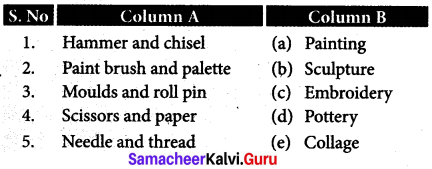
Answer:
- b
- a
- d
- e
- c
Listening
C. Listen to the teacher reading the passage. Read the questions given below, then listen to passage again and complete the responses.
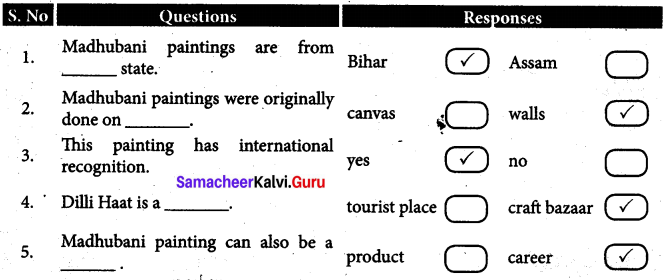
Speaking
D. Work in pairs. Find answers to these questions and present it to the class.
The Last Stone Carver Question And Answer Question 1.
Do you have art / craft session in your school?
Answer:
Yes, we do have art and craft session in our school.
The Last Stone Carver Question 2.
Which session do you like – art / craft?
Answer:
I like the craft session.
The Last Stone Carver Summary Question 3.
What do you do in that session?
Answer:
We make a lot of new models.
The Last Stone Carver 7th Standard Question 4.
Do you work individually or in pairs?
Answer:
We work in pairs and groups.
The Last Stone Carver Book Back Answer Question 5.
Can you do an art work or a craft work on your own?
Answer:
I can do a craft on my down. I can do a model of a house.
The Last Stone Carver Lesson Question 6.
What qualities do you gain by doing art or craft?
Answer:
- We can develop fine Motor skills.
- Art and craft improves Hand – Eye coordination.
- It boosts self-esteem and helps in socializing.
- It also promotes innovation and creativity in an individual.
Grammar
E. Construct meaningful sentences from the table given below

Answer:
- Silence should be maintained in libraries, hospitals etc.
- Cars should not be parked in ’No Parking’ area.
- Cleanliness should be practised at homes as well as in public places.
- Cell phones should not be used in petrol bunks.
- Junk food should be avoided as it is bad for health.
- Sweets should be avoided as they cause cavities and toothache.
F. Read the news report given below and underline the passive form of verbs.
7th English The Last Stone Carver Question 1.
The police had announced that the State Bank of India was robbed yesterday. Two men entered the bank at 4.30 pm with guns in their hands. Customers and bank clerks were asked to lie down on the floor, and one of the bank clerks was made to fill robbers’ bags with money.After that the two men left the bank quickly. The police officer said that more thgn pqe lakh of rupees was stolen from the bank but nobody was injured. He also added that the robbers would be found soon.
Answer:
The police had announced that the State Bank of India was robbed yesterday. Two men entered the bank at 4.30 pm with guns in their hands. Customers and bank clerks were asked to lie down on the floor, and one of the bank clerks was made to fill robbers’ bags with money. After that the two men left the bank quickly. The police officer said that more than one lakh of rupees was stolen from the bank but nobody was injured. He also added that the robbers would be found soon.
Work in pairs
G. Rani’s teacher narrates to her students about the production of paper. Read the following narration and fill in the blanks with the verbs using their passive form.
People of China produced paper from wood. They mixed water with the fibres of wood and dried it, until they became a soft wet pulp. They used this pulp to make paper. The Chinese invented this method of paper making in 2nd century BCE. Later Egyptians used papyrus plants to make paper.
- Paper (produce) from wood.
- The fibres of wood from trees (mix) with water to make a soft wet pulp.
- Later, it (dry) to make paper.
- This method (invent) in 2nd BCE in China.
- Papyrus plants (use) by Egyptians to make paper.
Answer:
- was produced
- was mixed
- was dried
- was invented!
- were used
H. Read the process of making soup. Use suitable passive form of verbs and complete the paragraph.
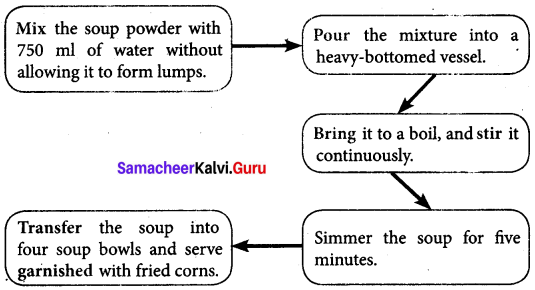
The packet is opened and the contents
- are mixed with 750 ml of water, without allowing it to form lumps. The mixture
- is poured into a heavy-bottomed vessel. It
- is boiled in low flame for five minutes. The soup
- is transferred into soup bowls and
- is garnished with fried corns.
Writing
I. If you are asked to choose from any one of these toys which one do you choose? Give reasons, (plastic toys, wooden toys, clay toys, metallic toys)
Answer:
I would choose wooden toys because they are much more special that the latest educational technology. Wooden toys bring a certain amount of nostalgia with them. It is also a durable material for toys. The more contact, we have With the plastic toys, the higher are the chances of health issues like asthma. So the wooden toys are better for safety and also good for the child’s brain. The quality and life span of wooden toys are much better than plastic toys and metallic toys.
J. Your friend has presented a beautiful art piece on your birthday. Write a letter to her appreciating her art work.
Answer:
5 th August 2019
Salem
Dear Lathika,
I am extremely happy to write this letter to you, as I am very happy after receiving your present on my birthday. It is an excellent piece of art. The art piece called “Glow of Hope” is also referred to as the “Woman with the lamp”. It is a master piece from
S.L. Haldankar, produced in 1945-1946. Water colours are used deliberately. The effect of this painting is heightened with the shadow behind the subject. It is such a wonderful art by him. I thank you so much for this excellent art piece as a gift to me.
Your loving friend
Amritha.
Creative Writing
K. You have prepared some eco-friendly craft materials like paper mache dolls, greeting cards, book marks, festoons, garlands, quilling jewellery etc for an Art Mela to be conducted in you school premises. Describe in a few sentences how you made the craft work. Include the following details in your writing.
- Name of the craft work
- Materials used
- Nature (handy / eco-friendly, longlasting / affordable price)
- Use (place / person / time)
Answer:
We have made eco-friendly craft materials like paper mache dolls, greeting cards, book marks, festoons, garlands, quilling Jewellery for the Art Mela conducted in your school premises. The paper mache dolls were Russian Nesting Dolls. Paper – mache is a composite material consisting of paper pieces or pulp, reinforced with textiles and bound with glue. The beautiful hand made Birthday cards were excellent. They were made with cardboard, glue, colour pencils, glitter papers and some paper flowers. Festoons, garlands made out of crepe paper and quilling jewellery made out of quilled paper and flowers were excellent exhibits in the Mela. They were also sold to the students at affordable prices. They were safe to be used by everyone, as they are handy and eco-friendly.
The Last Stone Carver Additional Questions
I. Choose The correct Synonyms from the option below.
The Last Stone Carver Short Summary Question 1.
heaps
(a) things
(b) piles
(c) toys
(d) bits
Answer:
(b) piles
The Last Stone Carver Story Question 2.
offered
(a) gave
(b) bought
(b) ordered
(d) begged
Answer:
(a) gave
The Last Stone Carver Lesson Plan Question 3.
ache
(a) worry
(b) pain
(c) hurt
(d) relief
Answer:
(b) pain
Summary Of The Last Stone Carver Question 4.
tourists
(a) guests
(b) people
(c) travellers
(d) local
Answer:
(c) travellers
Question 5.
admiration
(a) hate
(b) praise
(c) wonder
(d) dislike
Answer:
(b) praise
Question 6.
stunned
(a)shocked
(b) wondered
(c) wounded
(d) active
Answer:
(a) shocked
Question 7.
startled
(a) surprised
(b) worried
(c) walked
(d) bold
Answer:
(a) surprised
Question 8.
stumbled
(a) gain confidence
(b) lost balance
(c) found lost
(d) induced
Answer:
(b) lost balance
Question 9.
serene
(a) calm
(b) swoon
(c) pale
(d) wild
Answer:
(a) calm
Question 10.
congested
(a) confused
(b) returned
(c) overcrowded
(d) deserted
Answer:
(c) overcrowded
II. Pick the correct Antonyms,
1. flung
(a) throw
(b) held
(c) send
(d) focus
Answer:
(b) held
Question 2.
indifferently
(a) concerned
(b) not interested
(c) unconcern
(b) apathetic
Answer:
(a) concerned
Question 3.
determination
(a) firmness
(b) weak mindedness
(c) fixedness
(d) will power
Answer:
(b) weak mindedness
Question 4.
waning
(a) decreasing
(b) increasing
(c) fading
(d) shrinking
Answer:
(b) increasing
Question 5.
confidence
(a) trust
(b) belief
(c) distrust
(d) hope
Answer:
(c) distrust
Question 6.
drenched
(a) dried
(b)soaked
(c) wet
(d) doused
Answer:
(a) dried
Question 7.
whispered
(a) spoke softly
(b) murmured
(c) shouted
(d) muttered
Answer:
(c) shouted
Question 8.
deceived
(a) fooled
(b) enlightened
(c) cheated
(d) tricked
Answer:
(b) enlightened
Question 9.
clumsily
(a) gracefully
(b) awkwardly
(c) crudely
(d) ineptly
Answer:
(a) gracefully
Question 10.
arching
(a) bending
(b) curving
(c) bowing
(d) straight
Answer:
(d) straight
III. Choose the Correct Answer (MCQ).
Question 1.
The young man flung the hammer and the _______
(a) file
(b) knife
(c) chisel
(d) hacksaw
Answer:
(c) chisel
Question 2.
The windows opened into a tiny _______
(a) backyard
(b) garden
(c) portico
(d) hall
Answer:
(a) backyard
Question 3.
The old man a lot these days _______
(a) worked
(b) prayed
(c) suffered
(d) enjoyed
Answer:
(b) prayed
Question 4.
It was the features and _______
(a) legs
(b) face
(c) hands
(d) eyes
Answer:
(c) hands
Question 5.
There was something missing in his _______
(a) figures
(b) statues
(c) carvings
(d) drawing
Answer:
(a) figures
IV. Very Short Questions with Answers.
Question 1.
How did the old man work on the sculpture.
Answer:
He worked tirelessly on the sculpture.
Question 2.
When did Salim join the workshop of the old man?
Answer:
Salim joined the workshop of the old man five years ago.
Question 3.
What was the name of his son?
Answer:
His son’s name was Gopal.
Question 4.
What filled the old man with happiness and confidence?
Answer:
The cool metal of the tools filled him with happiness and confidence.
Question 5.
What did the old man have for his breakfast?
Answer:
The old man had a glass of milk for breakfast.
Question 6.
Who was chiselling the statue after the old man opened his eyes?
Answer:
Salim was chiselling the statue.
Question 7.
What did Salim want to become?
Answer:
He wanted to become a stone carver.
Question 8.
What statue did the old man carve?
Answer:
The old man carved the statue of Lord Krishna.
V. Short Questions with Answers.
Question 1.
Why was Gopal indifferent to his father’s profession?
Answer:
Gopal was more practical than his father. Gopal believed that being traditional, sculptors wouldn’t pay them for a decent life. He believed that making candle- stands, paper-weights and ashtrays would bring them good revenue.
Question 2.
Why was the master sculptor not able to understand his son’s stance?
Answer:
The master mason loved his work and didn’t want to change it for any other work in the world. He told his son that it was the work he had learnt from his father and had kept up the traditions for hundreds of years.
Question 3.
How did the master mason’s love for his work ruin his life?
Answer:
The man worked continuously without taking any rest for many days. His one desire was to finish the sculpture, which would be his last. He worked till his hands began to tremble and his shoulders started to ache. His arms grew heavy and his eyes grew tired then he couldn’t see anymore.
VI. Paragraph Questions with Answers.
Question 1.
What was wrong with masterjee?
Answer:
Masterjee, as he was known in his little village was a traditionalist. He was superstitious. He believed that Gods have entrusted the work of idol-making to his ancestors. So he, his sons and daughters should do the same work. For him, choosing another work – however profitable it was – was a sin. He was so much blind that he didn’t see the poverty that his family was suffering and had no commonsense to see that Gods would never want a group of people to starve and die.
Question 2.
Why did masterjee tell Salim that he was going to be the last stone-mason in his village?
Answer:
“Masterjee, Masterjee” Salim, the servant boy entered the workshop. His voice was filled with concern. He held a cup of tea in his hand. The old man lifted his head. He had a pale face and looked old and tired. He said, “Salim, soon I’ll be the last stone mason here, as everyone has gone to Agra. Look, Gopal my son has gone too. Now I’ll have to finish this sculpture all by myself. I can’t work with the chisel the way I used to do. But I have to finish the work and I will”.
The Last Stone Carver Grammer Additional
Passive Form
A. Rewrite the sentences using the passive forms of the verbs underlined.
Question 1.
He took the book.
Answer:
The book was taken by him.
Question 2.
She is writing the exam.
Answer:
The exam is being written by her.
Question 3.
The children sang a song
Answer:
A song was sung by the children.
Question 4.
She has submitted her work book
Answer:
Her work book has been submitted by her.
Question 5.
The carpenter will make a table for me.
Answer:
A table will be made by the Carpenter for me.
B. Fill in the blanks using the verbs in their passive form.
The young man flung the hammer and the chisel to the ground and cried “I’m leaving Father. I’m leaving you and this work. Look what it’s brought us!” He spread out his arms and glanced indifferently at the small congested workroom. The monsoons stained the white washed walls.
The hammer and chisel (i) ________ (flung) to the ground by the young man. He cried that he (ii) ________ (leave). His arms (iii) ________ (spread) out. The congested workroom (iv) ________ (glanced) indiferently by him. The white washed walls (v) ________ (stained) by monsoons.
Answer:
- were flung
- was leaving
- were spread
- was glanced
- were stained
C. Fill in the blanks using the passive form of verbs.
Today, a provision store (i) ______ (rob) by a group of people who (ii) ______ (catch) red-hand by the shop authorities. They (iii)_______ (hand over) to the police immediatly The culprits (iv) ______ (arrest) and (v) ______ (take) into the custody . the shop owners
(vi) ______ (request) by the police to fix a CCTV in the shop.
Answer:
- was robbed
- were caught
- were handed over
- were arrested
- were taken
- were requested
Warm up
Work in pairs.
Read the instructions given below, draw and name the picture
1. Draw a Letter A
2. Just below draw a letter B. So A is a cap for B.
3. Give B one eye, a round nose and a big mouth.
Answer:
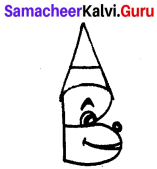
Write step by step instructions for the following picture.
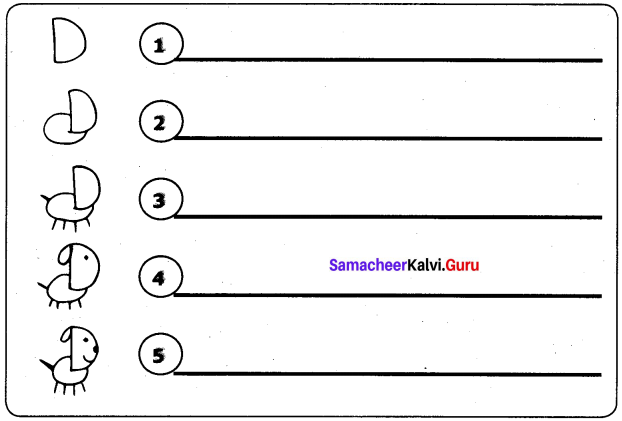
Answer:
1. Draw a letter ‘D’.
2. Draw a semi circle starting from the middle of ‘D’.
3. Draw a tail and four legs.
4. Draw an ear at the top of ‘D’.
5. Give a round nose and a big mouth.
The Last Stone Carver Summary
Section – I
An old man was a traditional sculptor. He made a living by making statues for temples. He did this work because he believed in traditions. His father was a sculptor, too. But his son Gopal was different. He used to argue with his father about the stupidity of not changing his profession for good. One day, Gopal went off home for Agra to be a more successful man in life. The old man knew that his son’s decision was good but he was helpless. He loved his traditions and his sculptures. After his son’s departure, he continued his work. He had a servant by named Salim who was very dedicated to him. He came to work there five years ago.
Which of the two sentences given below convey the following meaning?
Question 1.
stained by – mark made on clothe or materials
The white washed walls were stained by many monsoons.
(a) The walls were made dirty by rains.
(b) The Monsoon removed the dirt from the walls.
Answer:
(a) The walls were made dirty by rains.
Question 2.
working for a pittance – working for very little money I am tired of working for a pittance.
(a) He didn’t want to work because he was tired.
(b) He didn’t want to work as he gets low income for his work.
Answer:
(b) He didn’t want to work as he gets low income for his work.
Question 3.
ashen-pale
His face was ashen.
(a) He looked pale and dull.
(b) He looked bright and cheerful.
Answer:
(a) He looked pale and dull.
Question 4.
drenched – thoroughly wet
He is drenched to the skin.
(a) He is thin and skinny.
(b) He is thoroughly wet.
Answer:
(a) He is thin and skinny.
Section – II
The old man struggled hard for a month to complete the statue of Radha and Krishna. His hands were weak and his mind was weak. He didn’t feel hunger and thirst. His chisel was striking the stone / again and again. He had a strong desire to complete his work. He prayed and cried. He wanted his son to help him. Finally, in the wake of the day, the old man fainted.
Read the sentences and number them in correct order.
- The old man worked tirelessly on the sculpture.
- He had a strong wish to finish it in time.
- Over days, he felt very weak.
- He thought he wouldn’t be able to finish it.
- He wished to have Gopal with him.
- He realized that Gopal must learn to carve the finer details.
- Salim felt that it should come from within.
Section – III
Next day, when he opened his eyes, the old man saw someone completing the statue that! he had left unfinished. ‘Was it Gopal’, he thought. No, it was his servant boy, an orphan Salim. { Salim was sculpting Krishna’s statue in a wonderful way.
The old man watched everything with shock. The first wave of shock, fear and anger passed to give way to a feeling of great relief and happiness. Salim said that he had practised sculpting secretly for almost two years in the quarry. He wanted to become a sculptor like his master. He begged his master to teach him ‘Stone carving’. The old man told that there was nothing to teach him, as he already has it in his hands and heart. He has found his successor.
Read Section – III (para 1 and 4) and answer the following questions.
Paragraph 1
- Who listened to the chipping sound of the chisel? The old man
- Who was working with the hammer and chisel? Salim
Paragraph 4
- Who was staring? The old man
- Who was the young stone carver? Salim
- What was he working on? The face of the statue.